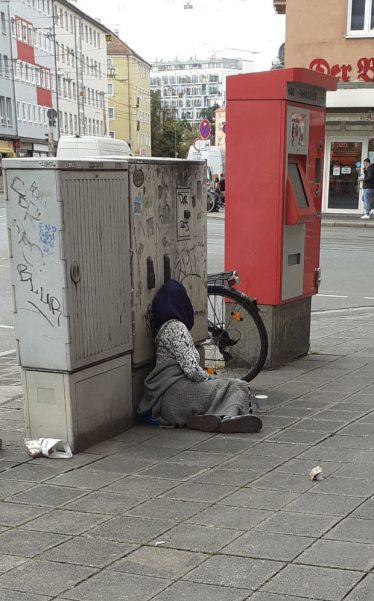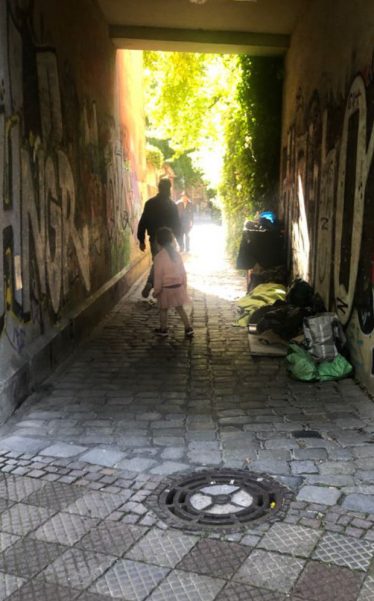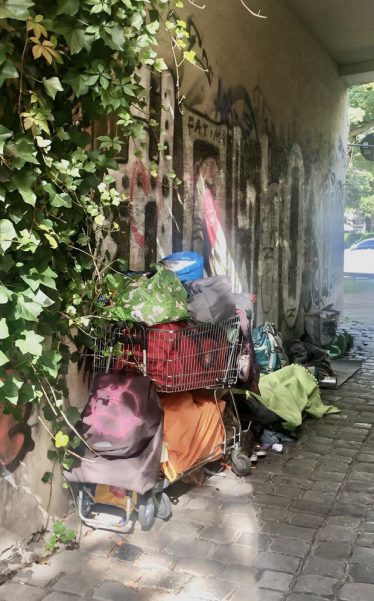It is 2022 and it pains me deeply that there continue to be people that live on the streets. People who live on the streets carry their few possessions with them, sleeping in the streets, in doorways or on piers, or in another space, on a more or less random basis.
People who are experiencing homelessness face many challenges, both emotional and physical, that make it even more difficult for them to get back on their feet.
A person is in a street situation when he or she is forced to carry out all survival activities in the public space. This phenomenon, which is both cause and consequence of multiple inequalities, transcends national borders; therefore, its study must also do so.
What it means
According to the Merriam-Webster dictionary, the word homeless is an adjective that means: having no home or permanent place of residence. The word street people, noun, means homeless people.

Back in 2004, the United Nations sector of Economic and Social Affairs defined a homeless household as those households without a shelter that would fall within the scope of living quarters due to a lack of or a steady income.
A few years later, in 2009, at the United Nations Economic Commission for Europe Conference of European Statisticians (CES), defined homelessness people under two broad groups: as:
Primary homelessness: persons living in the streets without a shelter that would fall within the scope of living quarters;
Secondary homelessness: persons with no place of usual residence who move frequently between various types of accommodations (including dwellings, shelters, and institutions for the homeless or other living quarters).
Homelessness is lacking stable and appropriate housing. People can be categorized as homeless if they are living on the streets or moving between temporary shelters.
Everyone has the right to a standard of living adequate for the health and well-being of himself and of his family, including food, clothing, housing, and medical care and necessary social services, and the right to security in the event of unemployment, sickness, disability, widowhood, old age or other lack of livelihood in circumstances beyond his control. – article 25 Universal Declaration of Human Rights –
The legal definition of homeless varies from country to country, or among different jurisdictions in the same country or region.
In 2005, an estimated 100 million people worldwide were homeless and as many as one billion people (one in 6.5 at the time) live as squatters, refugees, or in temporary shelters, all lacking adequate housing.
Historically in the Western countries, the majority of homeless have been men (50–80%), with single males particularly overrepresented.
The issue
This issue is not new, it is referred to as the demoniac of the land of the Gadarenes who did not live in the house but in the street and in cemeteries. Sadly, this social issue has been invisibilized or hidden in many opportunities.
Let us be clear about something, a person does not end up on the street from one day to the next. Their situation deteriorates over time and involves many causes; some depend on the person and others are related to the society in which we live.

There are several causes.
Structural: They are linked to the economic situation (such as job losses), the real estate market (rental prices, evictions), migratory movements, and the functioning of public administrations.
Institutional: Related to the rigidity of social services, assistance mechanisms, and institutional procedures.
Relational: Linked to the family situation and the person’s social support network (for example, a divorce or the death of a family member).
Personal: Related to education, age, dependency, and health.
Discrimination or lack of legal status: Related to the particular situations that immigrants and some minorities, such as the gypsy community, may experience.
The fact of the matter is that there are thousands and thousands of them who are registered in destitution, extreme poverty, unemployment, theft, and drugs.
The territorial scope
Figures in regards to this problem seem to change depending on territorial scope.
In the European Union, for example, there are no common criteria among the different countries to count how many people are sleeping rough and homeless, nor is there a total figure.
In all European countries, the number of people sleeping on the streets has increased in recent years, except in Finland and Norway.

It is important to note that, Article 31 of the European Social Charter guarantees the right to housing. It proposes to promote access to decent housing, to prevent and reduce homelessness progressively, and to ensure that the price of housing enables people with fewer resources to have a home. This is an important tool in the fight against poverty and exclusion.
Spain obtains data every two years from the National Institute of Statistics. However, these data only count the people who use housing and dining resources and exclude other people who sleep on the street and do not use these services. It should be noted that not all municipalities are counted either.
These are some of the facts that we know regarding the situation in Spain.
***Basque Country ***In a count conducted simultaneously in 26 Basque municipalities on the night of October 18-18, 2018, 435 people were counted sleeping rough. Most were sleeping on the streets of Bilbao (211 people), San Sebastian (106 people) and Vitoria (24 people).
*** Catalonia *** 1,516 people sleep on the streets in eleven Catalan municipalities (Barcelona, Tarragona, Girona, Lleida, L’Hospitalet de Llobregat, Badalona, Mataró, Terrassa, Santa Coloma de Gramenet, Sant Adrià de Besòs, Sabadell and Reus).
*** Madrid. *** In the Community of Madrid, there are at least 1,045 people sleeping on the streets.
*** Valencia ***A total of 568 people sleep on the streets in the city of Valencia and 220 are housed in shelters. In total there are 788 people according to the count organized in October 2019.
*** Zaragoza *** On November 14, 2018, 119 people were detected living on the street in Zaragoza. A census was also carried out the same night, which managed to interview 66 of these people to find out their situation.
The common denominator of people living on the streets in South America is that the majority are male; victims of extreme poverty and marked domestic violence.
In some countries, they sometimes meet their death due to adverse weather conditions. In the Mexican state of Aguas Calientes, the situation of street people is aggravated by low temperatures. In Chile, street dwellers often suffer even death in the winter season, when they have to endure sub-zero temperatures in the open air. In 2012, 28 homeless people died of homelessness, most of them in Santiago. In Montevideo, temporary shelters for homeless people become congested mainly when hostile weather conditions occur.
In Bogota, the number of street dwellers became evident when the mayor ordered the seizure of the Ele or Bronx, where thousands of people in that condition remained. In Brazil, these inhabitants were hidden on the occasion of the Pan-American Games and the last World Cup. In Ecuador, until 1971, street dwellers, known as vagrants and beggars, were criminally investigated when they faked illnesses to beg for alms.
In Santiago de Chile, street dwellers often temporarily occupy abandoned houses, malls, or shopping and food consumption centers, where street children are often invited to eat by foreign tourists. At night, an interdisciplinary team of the Program of Attention to Street Situations (PASC) goes through the streets of Montevideo to detect people in street situations.
In Caracas, being a highly urbanized city, a boom of street dwellers was generated in the last half-century, most of them occupying settlements. In border areas, as in Mexico, the problem is exacerbated by foreigners crossing the border, some of them ex-convicts, walking up and down the streets
Homeless children and adults living on the streets
Children wander around dirty and barefoot; the adults remain accompanied by pets, many with mental disorders, without any possibility of treatment. They sleep on the streets, sidewalks, under bridges, and on park benches.
When compared to the general population, people who are homeless experience higher rates of adverse physical and mental health outcomes.
Furthermore, people experiencing homelessness have limited access to resources and are often disengaged from health services, making them that much more susceptible to extreme weather events (e.g., extreme cold or heat).

Most countries provide a variety of services to assist homeless people. These services often provide food, shelter (beds), and clothing and may be organized and run by community organizations (often with the help of volunteers) or by government departments or agencies.
These programs may be supported by the government, charities, churches, and individual donors. Many cities also have street newspapers, which are publications designed to provide employment opportunities to homeless people.
What happen when Covid hit the world?
People who live on the streets may face more health issues than others. Many of the problems that people experiencing homelessness face can make their health worse, some of them include:
1. Limited access to health care
2. Not enough food
3. Trouble staying safe
4. Unsanitary living conditions
5. Exposure to severe weather
Well, when Covid- 19 hit the world everything flipped upside down. If the health situation is very complicated for people who have a house and medical facilities for someone who lives on the street the situation is really bad.

When Covid – 19 came into our lives, the first feelings were disbelief and misinformation. Most of us were housebound but people living on the street found themselves alone. They closed resources for showering, eating, and resting and it was weeks before others were opened.
According to the CDC (Centers for disease control and prevention), many people who are homeless are older adults or have underlying medical conditions they may also be at increased risk for severe illness than the general population. Consequently, they are a particularly vulnerable group. If possible, identifying non-congregate settings where those at increased risk can stay may help protect them from COVID-19.
Without a doubt, they are the invisible victims of Covid-19. No one seems to have any idea how many homeless people have died.
Most of the people living on the street, however, have not been able to be confined because they are homeless. They have found themselves alone on the street for days, with more police presence and changing information about resources closing and opening.
The first two weeks of the state of alarm and confinement were especially hard for people living on the streets. The closure of public parks forced many people to change where they slept; people who slept in closed ATMs and those who slept at the entrance of stations such as Sants had to be moved because private security had to throw them out.
The social canteens and the shower and closet services had to be readapted and about twenty were closed; the few locker rooms for leaving belongings during the day were also closed and there was no space left where people could take shelter or rest.
The measures taken by governments to address the Covid 19 pandemic were based on a family model with basic needs met and a habitat, which for millions of people – especially children – in Latin America, have been difficult or impossible to implement.
The challenge with the pandemic was to think of protection and care as a system. A holistic approach that incorporates the integrality of the child is fundamental.
Faced with this situation, it seems important to ask ourselves what happens to street children and teens, who maintain their link with the public space in order to carry out their survival practices. Social confinement not only does not seem to be a possibility for many of them, but in other cases, it can become situations that deepen their vulnerability.
Concluding
Homeless people face many challenges. When choosing where to roam, most of them prefer the center of the cities. There have been cases in which street dwellers are used for less than ethical and legal purposes.
Each night, hundreds of thousands of people experience homelessness somewhere in the world. Some of these people experience chronic homelessness, while others have temporarily lost their shelter. The reasons why they are homelessness are complex.
Experiencing homelessness, whether it is on a one-time or chronic basis, can leave basic needs ignored. Warmth, dry clothes, water, and food are never guaranteed each day. Without basic human needs being met, those experiencing homelessness might their situation more difficult to overcome.
Like no other inhabitant of the planet, these people live from day to day and do whatever it takes to survive. They are marginalized not just in life, but also in death.


